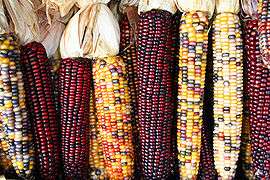Flint corn
Flint corn (Zea mays var. indurata; also known as Indian corn or sometimes calico corn) is a variant of maize, the same species as common corn.[1] Because each kernel has a hard outer layer to protect the soft endosperm, it is likened to being hard as flint; hence the name.[2] The six major types of corn are dent corn, flint corn, pod corn, popcorn, flour corn, and sweet corn.[3]
| Flint corn | |
|---|---|
 Flint corn is named for its hard kernels, which come in a multitude of colors | |
| Species | Zea mays |
| Variety | Zea mays var. indurata |
History
With less soft starch than dent corn (Zea mays indentata), flint corn does not have the dents in each kernel from which dent corn gets its name.[4] This is one of the three types of corn cultivated by Native Americans, both in New England and across the northern tier, including tribes such as the Pawnee on the Great Plains. Archeologists have found evidence of such corn cultivation in what is now the United States before 1000 BC.[5] Cultivation of corn occurred hundreds of years earlier among the Mississippian culture people, whose civilization arose based on population density and trade because of surplus corn crops.
Distinctive traits
Because flint corn has a very low water content, it is more resistant to freezing than other vegetables. It was the only Vermont crop to survive New England's infamous "Year Without a Summer" of 1816.[6]
Coloration
The coloration of flint corn is often different from white and yellow dent corns, many of which were bred later. Most flint corn is multi-colored. Like the Linnaeus variant of maize, any kernel may contain the yellow pigment zeaxanthin but at more varying concentrations.[7]
Uses
Popcorn (Zea mays everta, "corn turned inside out") is considered a variant of this type. It has a hard, slightly translucent kernel.[8]
Flint corn is also the type of corn preferred for making hominy, a staple food in the Americas since pre-Columbian times.
The flint corn cultivars that have large proportions of kernels with hues outside the yellow range are primarily used ornamentally as part of Thanksgiving decorations in the United States. They are often called either "ornamental corn" or "Indian corn", although each of those names has other meanings as well. These varieties can be popped and eaten as popcorn, although many people incorrectly believe that such colored varieties are not palatable or poisonous.
References
- jugalbandi.info Indian Corn
- "Seeds of Change Garden". www.mnh.si.edu. Archived from the original on July 22, 2009. Retrieved 2010-03-17.
- Linda Campbell Franklin, "Corn," in Andrew F. Smith (ed.), The Oxford Encyclopedia of Food and Drink in America. 2nd ed. Oxford: Oxford University Press, 2013 (pp. 551–558), p. 553.
- nmsu.edu Archived April 3, 2011, at the Wayback Machine Blue Corn Unique to American Southwest
- ", Lincoln, NE: University of Nebraska Press, 1965; reprint 1977, pp. 4–8, accessed 16 Dec 2009
- slowfoodusa.org Roy's Calais flint corn. Retrieved August 2011
- mnh.si.edu Archived July 22, 2009, at the Wayback Machine What kinds of corn are there?
- New Oxford American Dictionary
